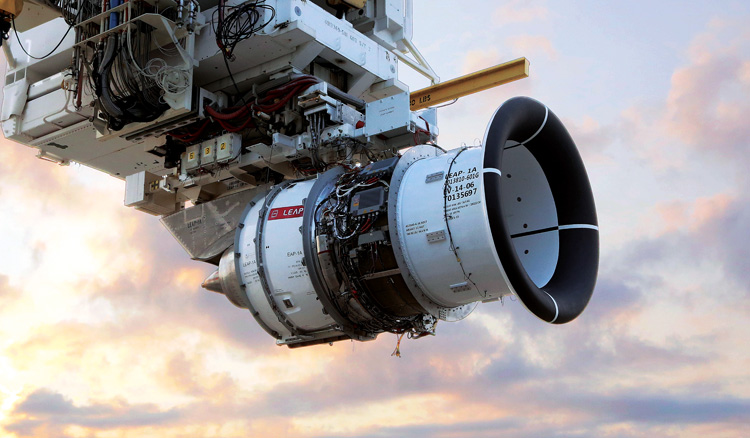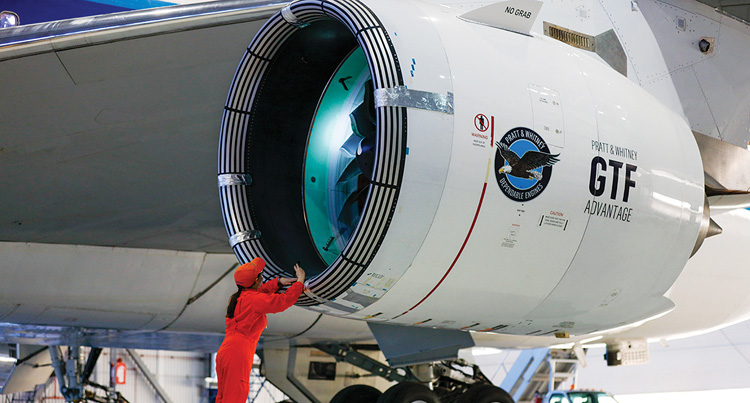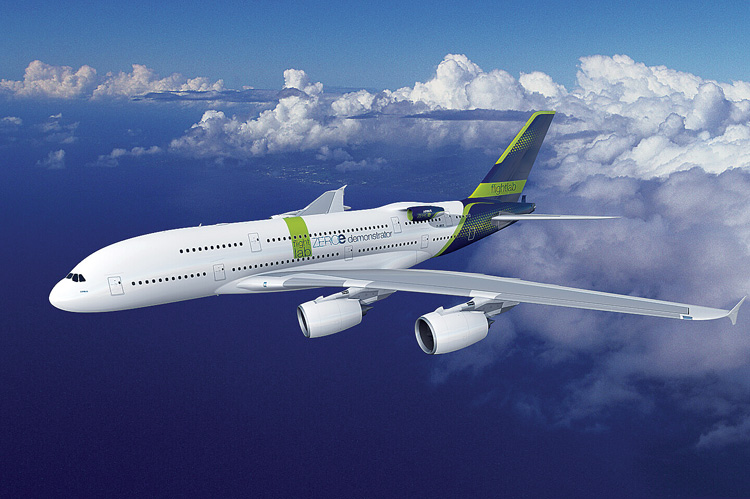INDIAN ARMED FORCES CHIEFS ON
OUR RELENTLESS AND FOCUSED PUBLISHING EFFORTS

SP Guide Publications puts forth a well compiled articulation of issues, pursuits and accomplishments of the Indian Army, over the years

I am confident that SP Guide Publications would continue to inform, inspire and influence.

My compliments to SP Guide Publications for informative and credible reportage on contemporary aerospace issues over the past six decades.
Aero Engine Makers & Green Initiatives
New aircraft and engine designs/technologies must look at engine fuel efficiency to carry more passengers and payload for lesser fuel burn

The terms ‘Sustainable Aviation’ or ‘Green Aviation’ are increasingly being used to address the technological and socio-economic issues facing the aviation industry to meet the environmental challenges of the twenty-first century. As air travel notches high growth, global aviation contributes about two per cent of global greenhouse gas emissions yet it supports eight per cent of the world economic activity. By 2025, it is estimated that the total CO2 emission due to commercial aviation may reach around 1.5 billion tonne. Aircraft noise may affect from 24 million in 2000 to 30.5 million by 2025. Therefore, there is urgency to address the problems of emissions and noise abatement through technological innovations. New aircraft and engine designs/technologies must look at engine fuel efficiency to carry more passengers and payload for lesser fuel burn.
The commercial aircraft turbofan engine market is dominated by a handful of major global players namely Pratt & Whitney, Rolls-Royce, General Electric (GE) Aviation and Safran. GE and Safran of France have a joint venture, called CFM. As per the report released by global business data platform ‘Statista’ in May 2021, CFM International had 39 per cent market share of the commercial aircraft engines in 2020.
FUEL EFFICIENCY IN LARGE JET ENGINES
Engine fuel efficiency has a direct impact on total consumption and in turn, on the cost of airline operations. As per IATA’s fuel fact sheet of October 2021, the global airline industry’s fuel bill estimated to reach $100 billion in 2021. In 2022, the fuel bill forecast was $132 billion, accounting for 19.5 per cent of operating expenses at around $67.0 per barrel Brent. This calculation has gone haywire with global crude oil benchmark Brent jumping to over $120 a barrel since the Ukraine conflict.
ENGINE FUEL EFFICIENCY IMPROVEMENTS
General Electric’s GE9X is the most fuel-efficient jet engine GE has ever produced on a per-pounds-of-thrust basis. It is designed to deliver a ten per cent improved fuel burn versus its GE90-115B. Based on proven GE90 architecture, the GEnx engine offers up to 15 per cent improved fuel efficiency and 15 per cent less CO2 compared to GE’s CF6 engine. It powers the 787 Dreamliner in addition to the four-engine Boeing 747-8. The Rolls-Royce Trent 7000, compared to the A330’s Trent 700, doubles the bypass ratio to 10:1 and halves emitted noise. Fuel consumption is improved by 11 per cent. Pratt & Whitney GTF engines powering A320neo has achieved a 16 per cent reduction in fuel consumption, a 75 per cent reduction in noise footprint and a 50 per cent reduction in nitrogen oxide emissions. CFM International’s LEAP engines make greater use of composite materials and the first FAAapproved 3D-printed components.

ENGINE TECHNOLOGY
The Adaptive Cycle Engine (ACE), unlike traditional engines with fixed airflow, is a variable cycle engine that will automatically alternate between a high-thrust mode for maximum power and a high-efficiency mode for optimum fuel savings. ACE is designed to increase aircraft thrust by up to 20 per cent, improve fuel consumption by 25 per cent and extend range by over 30 per cent. The ADaptive Versatile ENgine Technology (ADVENT) is an aircraft engine development programme with the goal of developing an efficient adaptive cycle or variable cycle engine for next generation aircraft. Rolls-Royce, GE Aviation and Pratt and Whitney are major participants. Modern, full-authority electronic digital controls of aircraft engines support improved engine efficiency and reduces fuel consumption.
SAGE INITIATIVES
Sustainable and Green Aero-Engines (SAGE) initiatives aim to develop engines with reduced CO2 emissions. Emissions of CO2, H2O, O2 and N2 are directly related to engine fuel burn efficiency. Use of lightweight low pressure turbofans; composite fan blades and high efficiency low pressure turbines; advanced engine externals and installations including novel noise attenuation; high efficiency Low Pressure (LP) spool with higher speeds and option of an aggressive mid turbine inter-duct. Developments in controls and electronics, lightweight metallic and composite materials, hydraulic and pneumatic systems and novel manufacturing methods, specific aero-engine parts, like casing, tanks, pipes, high temperature materials such turbine blades and sensors are being looked at. The SAGE 2 project headed by Rolls-Royce and Safran focuses on technologies such as composite propeller blades with aero-acoustic optimisation, electric de-icing system and equipment.
CAEP TARGETS
The aircraft engines account for most of the noise and fuel consumption characteristics of airplanes. The International Civil Aviation Organisation (ICAO) has a Committee on Aviation Environmental Protection (CAEP) since 1983. Aircraft are required to meet the engine certification standards adopted by ICAO. Of particular relevance is the Standard for NOx which is a greenhouse gas. The standard for NOx was first adopted in 1981. It was made more stringent in 1993, 1999, 2005 and 2011. CAEP/8 standard was set in 2010. The CAEP medium and longterm NOx technology goals were to target reduction by 45 per cent of CAEP/6 standard by 2016, and 60 per cent by 2026. These targets have yet to be met fully. ICAO is developing the first non-volatile PM (nvPM) standards covering soot or black carbon particles, for turbofan/turbojet engines. The nvPM standard will help better assess impact.
POLICY AND OPERATING ISSUES
FAA Modernisation and Reform Act of 2012 brought in the need for aviation fuel research and development, review of energy and environment related issues. Fuel efficient engines remain the greatest factor, but other factors like airframe design, cruise speed choice also make an impact on improved fuel efficiency.
CFM — Green initiatives
CFM INTERNATIONAL IS A 50:50 JOINT VENTURE BETWEEN
GE Aircraft Engines and SNECMA of France. More than 35,000 CFM engines have been delivered to over 600 operators around the globe, accumulating one billion plus flight hours.
LEAP ENGINES
They had created the very successful CFM56 series that is powering the Boeing 737, Airbus A340 and A318 to A321 family of aircraft. Their Leading Edge Aviation Propulsion (LEAP) engines entered service in 2016. LEAP delivers 15 per cent improvement in fuel consumption over CFM56. Over 2,500 LEAP engine variants are flying on Airbus A320neo, Boeing 737 MAX and COMAC C919. The company claims overflowing order books and intend to make 2,000 engines in 2023. GE and India’s Tata group entered into a strategic partnership to manufacture LEAP engine components in India. These will be sourced for GE’s global supply chain.
RISE PROGRAMME
GE Aviation and Safran’s CFM RISE (Revolutionary Innovation for Sustainable Engines) bring in bold technology targeting over 20 per cent lower fuel consumption and CO2 emissions compared to today’s engines. The programme will demonstrate and mature a range of new, disruptive technologies for future engines that could enter service by the mid-2030s. It will reinvent the future of flight that will take the next generation of single-aisle aircraft to a new level of fuel efficiency and reduced emissions. The two have extended their partnership to the year 2050 with intent to lead the way for more sustainable aviation and to half CO2 emissions by 2050. Their LEAP engine launched in 2008 already reduces emissions by 15 per cent compared to previous generation engines. The technologies from the RISE Programme will serve as the foundation for the next-generation CFM engine that could be available by the mid-2030s. It will bring 100 per cent compatibility with alternative energy sources such as Sustainable Aviation Fuels and hydrogen. The state-of-the-art propulsive efficiency for the engine, including developing an open fan architecture. The programme will also use the hybrid electric capability to optimise engine efficiency while enabling the electrification of several aircraft systems.

FUTURE DEVELOPMENT
CFM and Airbus have signed an agreement to collaborate on a hydrogen demonstration programme that will take flight around the middle of this decade. The programme objective is to ground and flight test a direct combustion engine fueled by hydrogen, in preparation for entry-into-service of a zero-emission aircraft by 2035.
CFM will modify the combustor, fuel system, and control system of a GE Passport turbofan to run on hydrogen. The engine, which is assembled in the US, was selected because of its physical size, advanced turbo machinery, and fuel flow capability. The demonstration will use a A380 flying testbed equipped with liquid hydrogen tanks prepared at Airbus facilities in France and Germany. Airbus will define the hydrogen propulsion system requirements, oversee flight testing, and provide the A380 platform to test the hydrogen combustion engine in cruise phase.
CFM shares Airbus’ ambition of fulfilling the promise they made in signing the Air Transport Action Group goal in October 2021 to achieve aviation industry net-zero carbon emissions by 2050 by developing and testing the technology necessary to make a zero emission aircraft a reality within the ambitious timeline defined.
ICAO AND IATA PROPULSION TECHNOLOGY ROADMAP
The ICAO states that air vehicles fuel consumption has been dropping by one to two per cent annually since 1960. At the 2010 ICAO meeting, it was decided for two per cent fuel saving per year up to 2020, and neutralisation of carbon value as specified in Paris. A three per cent fuel saving target for each year was set for International Air Transport Association (IATA) member airlines.
Ten to 15 per cent savings were expected from higher pressure and bypass ratios, lighter materials, implemented by 2020. 20 to 25 per cent from high pressure core and ultrahigh by-pass ratio geared turbofan between 2020 and 2025. 30 per cent from "open rotors", from 2030 onwards; 40 to 80 per cent from Hybrid electric propulsion (depending on battery use), from 2030-2040. And up to 100 per cent due to fully electric propulsion (primary energy from renewable source), from 2035-2040.
THE WAY AHEAD
NASA indicates that with advanced aerodynamics, structures and geared turbofans, fuel savings of up to 50 per cent by 2025, is possible and 60 per cent by 2030, with new ultra-efficient configurations and propulsion. By 2030, hybrid-electric architectures may be ready for 100-seater airplanes. Engines embedded in the tail to ingest the low-energy fuselage boundary layer flow and re-energise the wake to reduce drag, are being considered by many designers. Boeing’s ecoDemonstrator programme is meant to enhance safety and reduce fuel use, emissions and noise. The Airbus/Rolls-Royce E-Thrust is a hybrid electric with a gas turbine engine and electric ducted fans with high energy storage batteries. Empirical Systems Aerospace is developing the 150-seat ECO-150 concept for turbo-electric distributed propulsion with two turbo-shaft engines mounted on the wing and driving generators powering ducted fans and improving propulsive efficiency for 20 to 30 per cent fuel savings.





